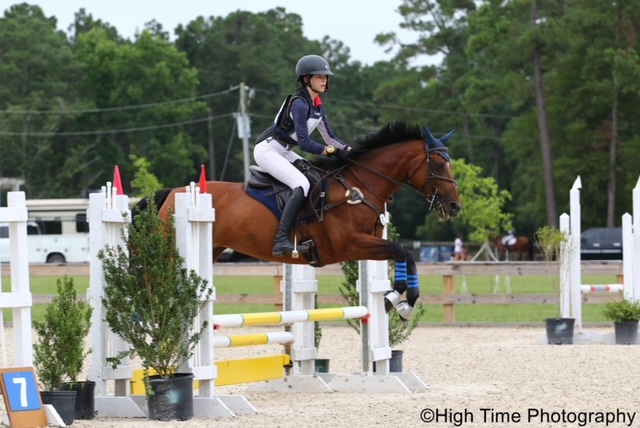Overall: My first impression is that this rider is behind the motion of her horse, getting a little left at the fence and using his mouth for balance. You can see that she’s pulling on his mouth because the bit is making him “smile,” and he looks a little unhappy.
Leg: The stirrup is behind the ball of her foot—it needs to move closer to her toe so it’s right under the ball of her foot. Then she can press her heel down more. I think her stirrup length is too short for this fence height. She could lengthen it so there’s not so much angle in her knee. This is causing her to push her seat too far to the back of the saddle. She’s compensating being behind the horse’s motion by pinching with her knee instead of having her weight in her heel and more contact with the back of her calf.
Seat/hip angle: While her seat is far back in the saddle, her hip angle is too open. It’s like she opened her position too early in the air or got a little left.
Release: She needs more release by reaching a little farther up her horse’s neck and pressing her hands into it. This will help her not interfere with her horse’s ability to use his head and neck to jump.
Upper body: She has good posture with her back, and her eyes are looking up and ahead to the next fence, which is good.
Horse: The horse looks like a capable jumper at this height.
Turnout: The turnout is excellent. The horse’s coat looks shiny and beautiful. Her equipment is clean, and her boots are polished.

What you’ll see on the video: This is a good round, but the rider is often behind the horse’s motion on course. I’d like to see her hip angle closed more in her two-point position and her seat over the pommel of the saddle in the air. In some areas, she’s so far to the back of the saddle, she’s posting at the canter.
Because of these position faults, she starts to fall back in the air in some places, which is why in the photo, she’s using the horse’s mouth for balance. In some areas, her release is too short, and when it is correct, it’s floating. I want to see that release go right into the horse’s neck. At this fence height, you can grab a little mane if you feel like you’re falling back just so you don’t catch the horse in his mouth.
Later on course, the rider is having a hard time making a turn because her weight is in the outside stirrup. You want to weight your inside stirrup to make the turn, and the horse will try to stay under you better. During the video, you can hear her talking and telling her horse he’s good, which is fine, but it’s a little overdone. Saying a simple “good” would suffice instead of more. This would help her concentrate more on her course and how to ride it.
About Beezie Madden
Beezie Madden captured Olympic show-jumping team gold medals in 2004 as well as 2008, where she also earned the individual bronze medal, all riding Authentic. She won the FEI Jumping World Cup™ Final in 2013 with Simon and in 2018 with Breitling LS. Other accolades include an Olympic team silver medal in 2016 riding Cortes ‘C’, with whom she also took World Equestrian Games team and individual bronze medals. S Most recently, she won the prestigious CP ‘International’ at CSIO Spruce Meadows in September. he and her husband, John, are based out of John Madden Sales in Cazenovia, New York.
This article originally appeared in the Spring 2023 issue of Practical Horseman.










